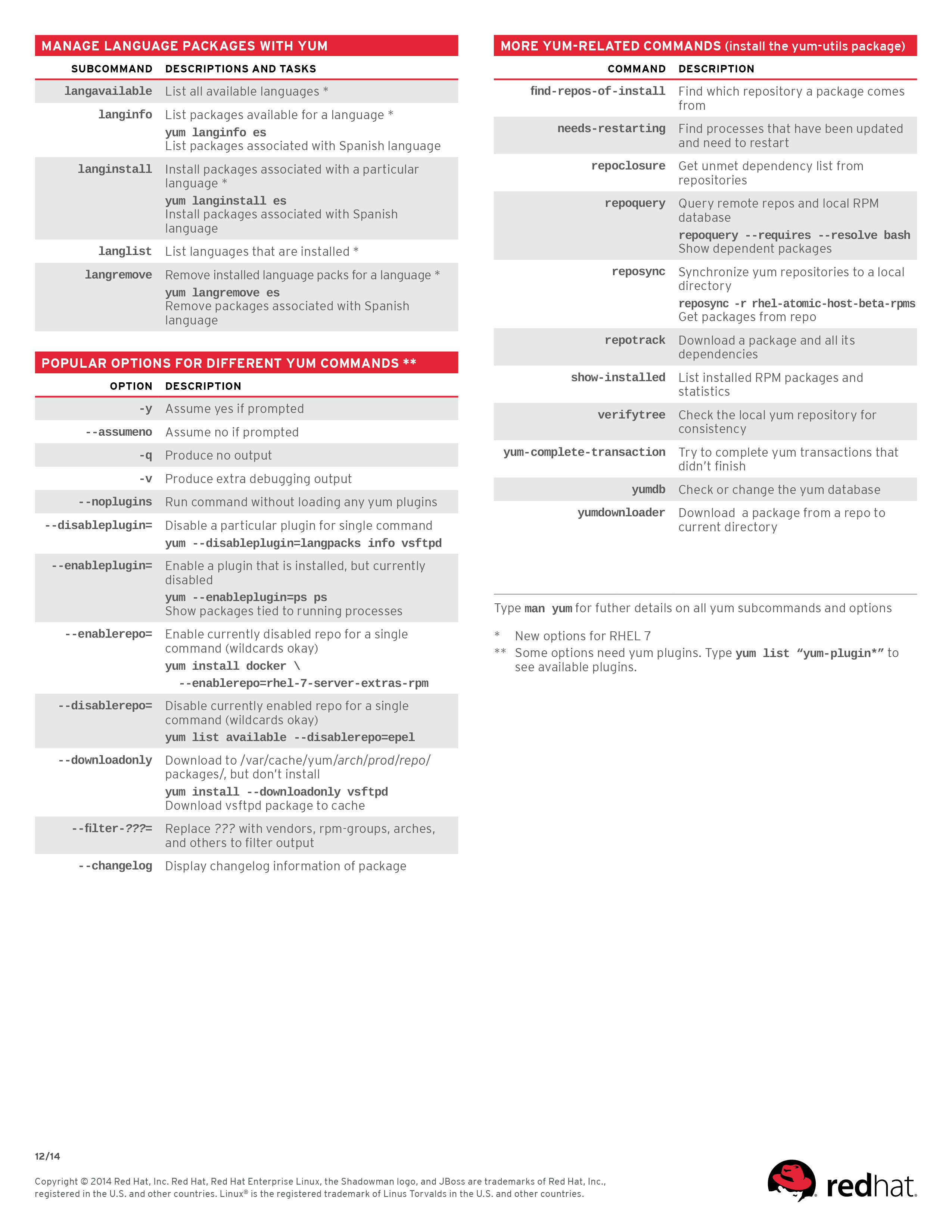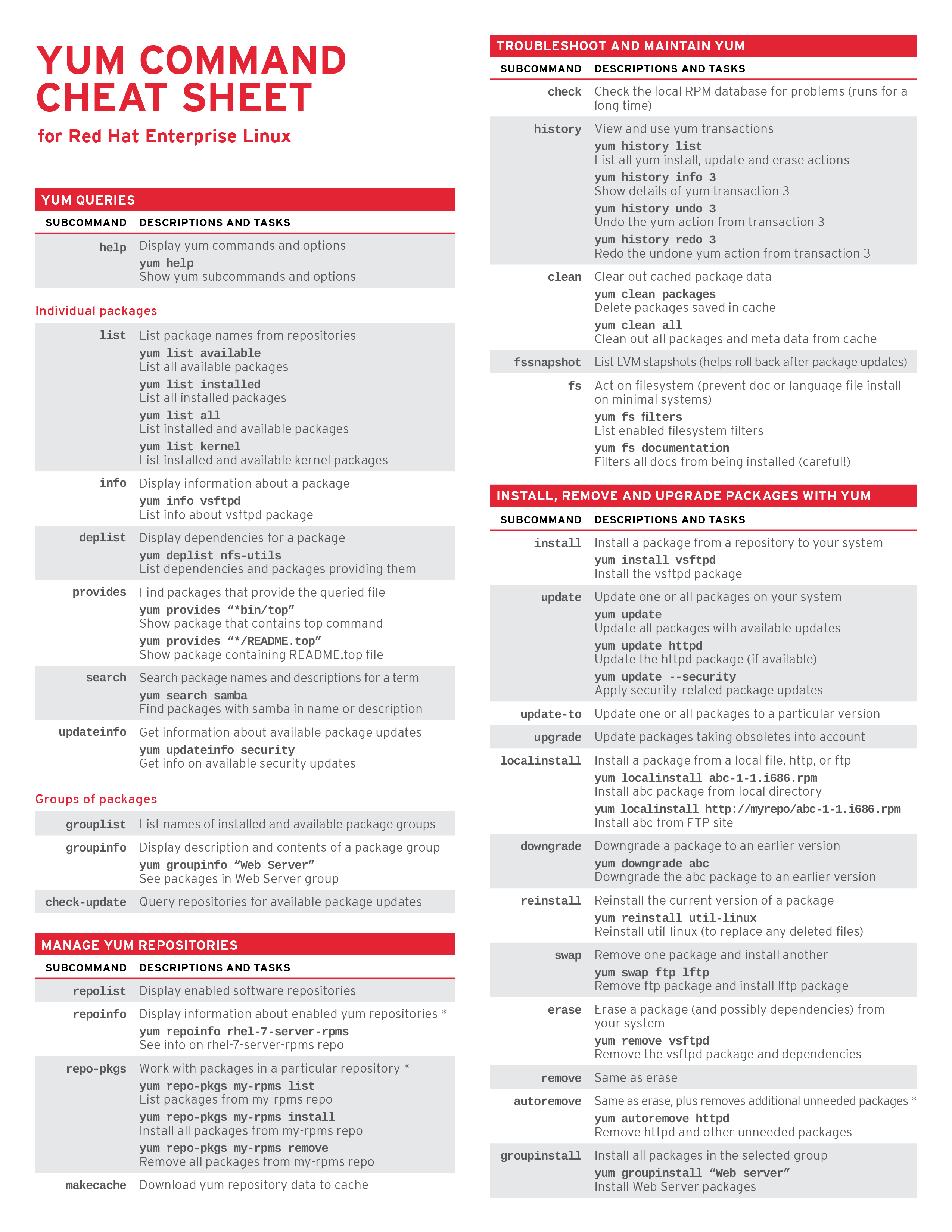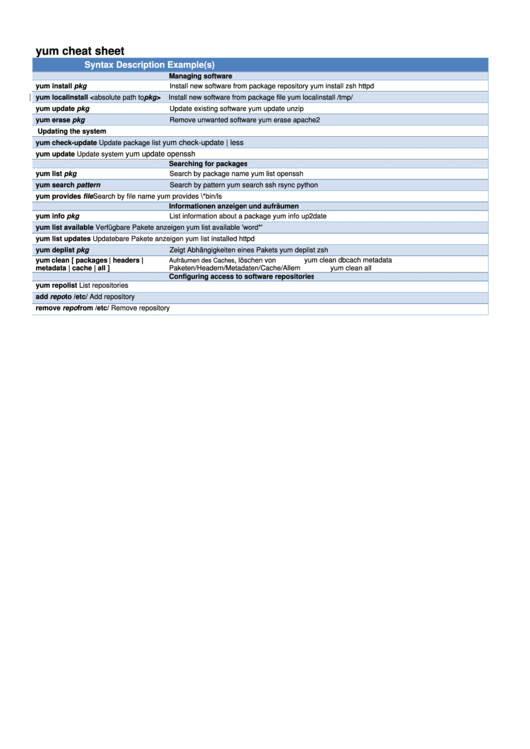Yum Cheat Sheet - By default, yum queries your remote repositories every single time you run it, which are listed in /etc/yum.repos.d. It allows users to install, update, remove, and manage packages in a simple way, automatically resolving dependencies and. A pdf document that summarizes the syntax, description and examples of yum commands for managing software, updating the system,. Usage, examples, links, snippets, and more.
By default, yum queries your remote repositories every single time you run it, which are listed in /etc/yum.repos.d. A pdf document that summarizes the syntax, description and examples of yum commands for managing software, updating the system,. It allows users to install, update, remove, and manage packages in a simple way, automatically resolving dependencies and. Usage, examples, links, snippets, and more.
It allows users to install, update, remove, and manage packages in a simple way, automatically resolving dependencies and. By default, yum queries your remote repositories every single time you run it, which are listed in /etc/yum.repos.d. A pdf document that summarizes the syntax, description and examples of yum commands for managing software, updating the system,. Usage, examples, links, snippets, and more.
Yum Yellowdog Updater Modified Cheat Sheet printable pdf download
A pdf document that summarizes the syntax, description and examples of yum commands for managing software, updating the system,. By default, yum queries your remote repositories every single time you run it, which are listed in /etc/yum.repos.d. It allows users to install, update, remove, and manage packages in a simple way, automatically resolving dependencies and. Usage, examples, links, snippets, and.
YUM Cheat Sheet by misterrabinhalder
By default, yum queries your remote repositories every single time you run it, which are listed in /etc/yum.repos.d. It allows users to install, update, remove, and manage packages in a simple way, automatically resolving dependencies and. Usage, examples, links, snippets, and more. A pdf document that summarizes the syntax, description and examples of yum commands for managing software, updating the.
25+ yum command examples in Linux [Cheat Sheet] GoLinuxCloud
By default, yum queries your remote repositories every single time you run it, which are listed in /etc/yum.repos.d. It allows users to install, update, remove, and manage packages in a simple way, automatically resolving dependencies and. A pdf document that summarizes the syntax, description and examples of yum commands for managing software, updating the system,. Usage, examples, links, snippets, and.
Red Hat Enterprise Linux の Yum コマンドのチートシート Red Hat Customer Portal
It allows users to install, update, remove, and manage packages in a simple way, automatically resolving dependencies and. By default, yum queries your remote repositories every single time you run it, which are listed in /etc/yum.repos.d. Usage, examples, links, snippets, and more. A pdf document that summarizes the syntax, description and examples of yum commands for managing software, updating the.
Red Hat Enterprise Linux の Yum コマンドのチートシート Red Hat Customer Portal
It allows users to install, update, remove, and manage packages in a simple way, automatically resolving dependencies and. Usage, examples, links, snippets, and more. By default, yum queries your remote repositories every single time you run it, which are listed in /etc/yum.repos.d. A pdf document that summarizes the syntax, description and examples of yum commands for managing software, updating the.
Yum Command Cheat Sheet for Red Hat Enterprise Linux Red Hat Customer
By default, yum queries your remote repositories every single time you run it, which are listed in /etc/yum.repos.d. A pdf document that summarizes the syntax, description and examples of yum commands for managing software, updating the system,. It allows users to install, update, remove, and manage packages in a simple way, automatically resolving dependencies and. Usage, examples, links, snippets, and.
Yum Command Cheat Sheet for Red Hat Enterprise Linux Red Hat Customer
A pdf document that summarizes the syntax, description and examples of yum commands for managing software, updating the system,. By default, yum queries your remote repositories every single time you run it, which are listed in /etc/yum.repos.d. Usage, examples, links, snippets, and more. It allows users to install, update, remove, and manage packages in a simple way, automatically resolving dependencies.
linux network commands cheat sheet pdf
Usage, examples, links, snippets, and more. By default, yum queries your remote repositories every single time you run it, which are listed in /etc/yum.repos.d. A pdf document that summarizes the syntax, description and examples of yum commands for managing software, updating the system,. It allows users to install, update, remove, and manage packages in a simple way, automatically resolving dependencies.
Top Yum Cheat Sheets free to download in PDF format
It allows users to install, update, remove, and manage packages in a simple way, automatically resolving dependencies and. A pdf document that summarizes the syntax, description and examples of yum commands for managing software, updating the system,. Usage, examples, links, snippets, and more. By default, yum queries your remote repositories every single time you run it, which are listed in.
centos 7 commands cheat sheet pdf
Usage, examples, links, snippets, and more. It allows users to install, update, remove, and manage packages in a simple way, automatically resolving dependencies and. By default, yum queries your remote repositories every single time you run it, which are listed in /etc/yum.repos.d. A pdf document that summarizes the syntax, description and examples of yum commands for managing software, updating the.
Usage, Examples, Links, Snippets, And More.
It allows users to install, update, remove, and manage packages in a simple way, automatically resolving dependencies and. By default, yum queries your remote repositories every single time you run it, which are listed in /etc/yum.repos.d. A pdf document that summarizes the syntax, description and examples of yum commands for managing software, updating the system,.


![25+ yum command examples in Linux [Cheat Sheet] GoLinuxCloud](https://www.golinuxcloud.com/wp-content/uploads/yum_command.jpg)






